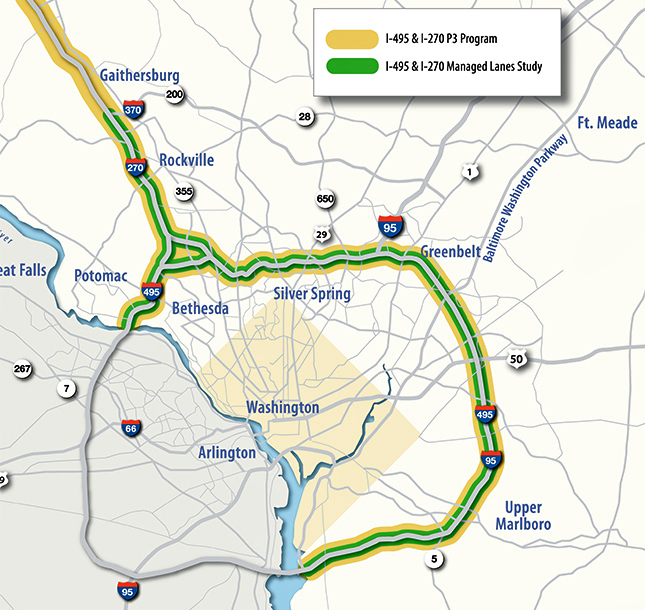In order to address the area’s impending traffic build-up, a proposition, dubbed the P3 Program, is under consideration by the State of Maryland that could result in the widening of sections of I-270, I-495 and the Baltimore-Washington Parkway (see map on page 13). This could have negative effects on daily life in Greenbelt and on nearby National Park Service properties. Both the Greenbelt City Council and the Four Cities Coalition, which includes Greenbelt, College Park, Berwyn Heights and New Carrollton, have issued statements to the Office of the Governor stating their opposition to the proposal.
In the letter from council, Mayor Emmett Jordan stated the wish to “allow an opportunity for the state transportation agencies to pursue other congestion relief approaches. We can collectively work towards developing a plan that will relieve traffic congestion on our highways while minimizing impacts to the natural and built environment.” Jordan cited studies that indicated that highway expansion projects ultimately do not relieve congestion. Such projects encourage more driving, longer trips and increase suburban sprawl leading to environmental damage, stressed highway management and a general drain on taxpayer money and time.
According to their website (http://495-270-p3.com), the State of Maryland has initiated a Managed Lanes Study to examine I-495 from north of the American Legion Bridge to east of the Woodrow Wilson Bridge and along I-270 from I-495 to I-370, including the east and west I-270 Spurs. A managed lane is defined as a measure to enhance traffic speed and safety, as well as quelling air pollution. This can mean a variety of options, including lane use restrictions, and toll, HOV, reversible and bus lanes. The website goes on to say that the study will “evaluate alternatives to accommodate existing and future traffic, improve trip reliability, expand travel options, accommodate homeland security, and improve the movement of goods and services.”
In regard to the Parkway, (which, according to Jordan, holds a place of great historic and cultural significance) a 2012 Baltimore-Washington Parkway Widening Feasibility Study determined that such a measure would “likely result in levels of traffic congestion similar to those experienced today” due to “anticipated regional population and employment growth” with the resultant “magnitude of increased travel demand.” The Parkway is included on the National Register of Historical Places. The proposed widening would impinge on the tract maintained by the National Park Service, this being the 19-mile area from Route 175 to the D.C. border. Said Jordan, the Parkway “deserves to be respected for its original function as a scenic byway.”
Greenbelt resident Aaron Marcavitch attended an open house at Eleanor Roosevelt High School on April 24, where the details of the issue were presented to the public. His assessment was that the plans are at the kick-off stage, with few specific details available on possible widening or the addition of tolls. There was no deliberate addressing of the Parkway and when Marcavitch asked about the widening, the response was that it would require “an act of Congress.” The City of Greenbelt and the Four Cities Coalition have encouraged the state to advocate for the expansion in use and funding of transit and alternative transportation systems and increased hours of operation for MARC trains, in place of significant highway development. Jordan stated the effect this step “will have on the natural, socioeconomic, cultural and built environments is unacceptable. Established neighborhoods adjacent to these highway corridors will be negatively impacted by a diminished quality of life, as will users of the Parkway.”

